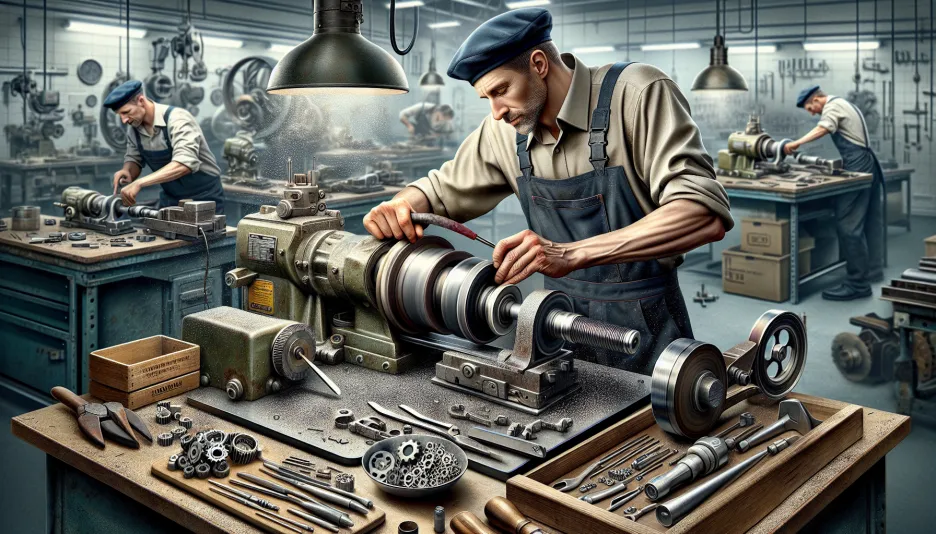- Salary statistics
- Belt sharpener
Belt sharpener salary
32 000 - 34 200 kr / month
Industriell tillverkning
Salary progression Belt sharpener

Grinder: A Profession within Industrial Manufacturing
Working as a grinder means being an essential part of the industrial manufacturing process. Your main task is to grind and polish various types of tools and components to meet specific quality requirements. The job may involve handling both manual and machine-driven grinding tools, requiring precision and accuracy to ensure all surfaces are smooth and functional. It is a profession that demands technical skill and a good understanding of materials and tools.
What Does a Grinder Earn?
Within the grinder profession, the average salary is 34 200 kronor per month. This marks an increase from previous measurements where the average salary was 33 100 kronor. For men, the average salary is around 34 100 kronor. However, specific salary data for women in this profession is currently unavailable. For those working on an hourly basis, which is not uncommon, the hourly wage is approximately 206 kronor, based on 166 working hours per month.
Salary Dynamics and Future Prospects
The salary for a grinder has seen a modest increase in the past year, indicating a stable demand within the profession. Forecasts from the Swedish Public Employment Service do not specify the exact future prospects for grinders, but the profession is part of the broader field of industrial manufacturing. It is important to note that the lack of specific future assessments may be due to limited data.
Education and Skills Requirements
To become a grinder, it is often advantageous to have a technical high school education or equivalent experience in metalworking or workshop technology. Many employers also offer internal training to ensure that employees have the right skills for the specific machinery and tools used. These training programs can be a significant advantage for those looking to advance in the profession.
Working Conditions and Environment
Grinders often work in workshop environments where the noise level can be high and the working conditions demanding. The use of protective equipment is common to shield against noise and dust. It is also important to have good physical health as the work can be physically demanding and involve a lot of standing. Despite these challenges, many find the work satisfying due to the technical challenge and the opportunity to work with high precision.
Benefits and Employer Offers
While not standard for all, some employers in the industry may offer benefits such as paid training and courses to promote employee development. Other potential benefits may include wellness subsidies and access to employee discounts on tools and equipment.
Challenges and Competition
One of the biggest challenges in the grinder profession is staying updated on new technology and methods in grinding and polishing. Competition can vary depending on the region and demand, but since the profession requires specialized knowledge, it is often a relatively stable job market for those with the right skills.
Summary and Recommendations
For those interested in a technically challenging and hands-on career, working as a grinder can be an excellent choice. With a competitive salary and opportunities for further education, it is a career path that offers both stability and development possibilities. Keeping up with technological advancements and improving technical skills will be crucial for success in this field.
Salary distributed by age and sector
| Age | Base salary | Monthly salary | |
|---|---|---|---|
| 45-54 | 32900 kr | 35000 kr | |
| 55-64 | 33900 kr | 36200 kr | |
| Snitt | 32000 kr | 34200 kr |
| Age | Base salary | Monthly salary | |
|---|---|---|---|
| 45-54 | 32900 kr | 35000 kr | |
| 55-64 | 33900 kr | 36200 kr | |
| Snitt | 32000 kr | 34200 kr |
| Age | Base salary | Monthly salary | |
|---|---|---|---|
| 45-54 | 32900 kr | 35000 kr | |
| 55-64 | 33900 kr | 36200 kr | |
| Snitt | 32000 kr | 34200 kr |
| Age | Base salary | Monthly salary | |
|---|---|---|---|
| 55-64 | 33900 kr | 36000 kr | |
| Snitt | 32000 kr | 34100 kr |
| Age | Base salary | Monthly salary | |
|---|---|---|---|
| 55-64 | 33900 kr | 36000 kr | |
| Snitt | 32000 kr | 34100 kr |
| Age | Base salary | Monthly salary | |
|---|---|---|---|
| 55-64 | 33900 kr | 36000 kr | |
| Snitt | 32000 kr | 34100 kr |
About the data
All information displayed on this page is based on data from the Swedish Central Bureau of Statistics (SCB), the Swedish Tax Agency and the Swedish employment agency. Learn more about our data and data sources here.
All figures are gross salaries, meaning salaries before tax. The average salary, or mean salary, is calculated by adding up the total salary for all individuals within the profession and dividing it by the number of individuals. For specific job categories, we have also considered various criteria such as experience and education.
Profession Belt sharpener has the SSYK code 7224, which we use to match against the SCB database to obtain the latest salary statistics.
-

Grinders etc.
-

Stonemasons etc.
-

Machine operators, filling, packing and labeling
-
Operators in sawmills, planing mills and plywood etc.
-
Machine operators, bleaching, dyeing and washing
-

Machine operator, mineral wool
Other process and machine operators
-
 Electricity prices
Electricity pricesFree Electricity During the Night and Rising Prices Tomorrow
Mon, 25 Nov 2024 - 13:02 -
 Municipality
MunicipalityTax Pressure in Kiruna Municipality - An Overview of Tax Rates and Economic Challenges
Thu, 23 May 2024 - 22:26





